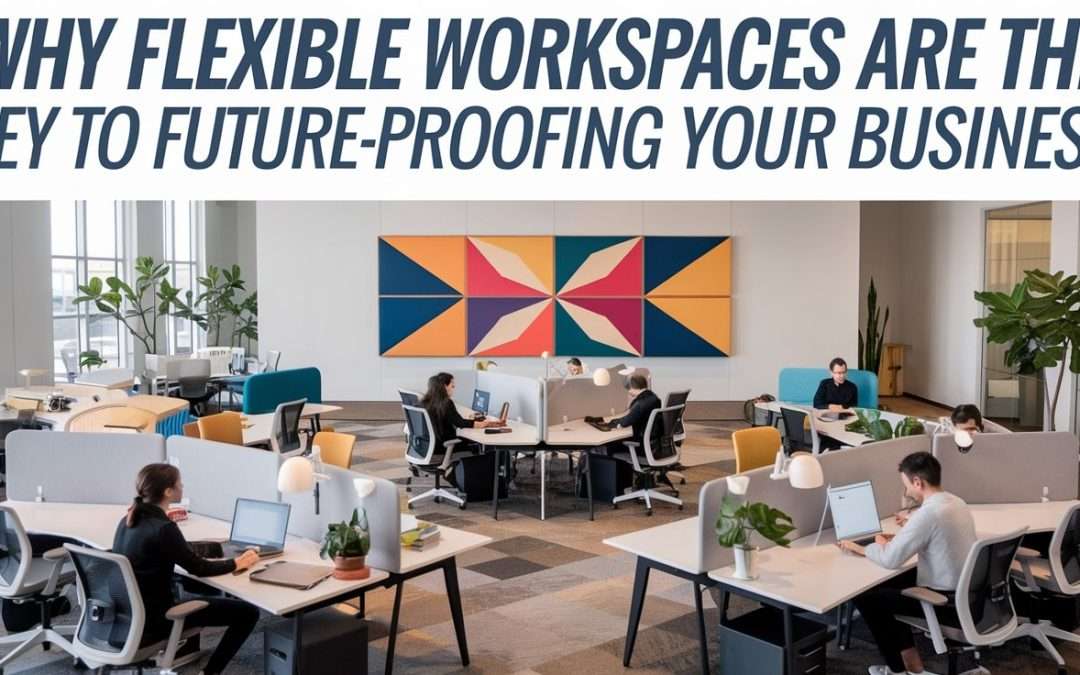The way businesses operate is changing rapidly. With remote work, hybrid teams, and shifting market demands, companies need office solutions that can adapt and scale. Traditional office spaces often come with long-term leases and high overhead costs, making them less suitable for businesses looking for flexibility.
This is where flexible workspaces come in. They provide businesses with cost-effective, scalable, and productivity-boosting environments without the commitment of a traditional office. In this blog, we’ll explore how flexible workspaces can help future-proof your business and keep you competitive.
What Are Flexible Workspaces?
A flexible workspace is an office environment designed to accommodate different working styles, team sizes, and business needs. These spaces allow businesses to rent workstations, private offices, or meeting rooms on a short-term or long-term basis.

Common types of flexible workspaces include:
Coworking Spaces – Shared office spaces where professionals and businesses work independently but in a collaborative setting.
Private Offices – Fully serviced offices that offer privacy and flexibility without long-term contracts.
Hot Desking – Desks that are available on demand, allowing employees to work from different locations as needed.
Virtual Offices – A business address and office services without the need for a physical space.
Flexible workspaces provide businesses with the freedom to scale, reduce costs, and improve efficiency while maintaining a professional presence.
Why Businesses Are Moving Towards Flexible Workspaces
1. Cost Savings and Financial Flexibility
Running a traditional office requires significant investment in rent, utilities, furniture, and maintenance. Flexible workspaces eliminate these expenses, allowing businesses to:
- Pay only for the space they use.
- Avoid costs associated with office maintenance and utilities.
- Reinvest saved funds into business growth.
For startups and small businesses, this can be a game-changer, as they can access premium office facilities without high upfront costs.
2. Scalability Without Long-Term Commitments
Business needs can change quickly. A flexible workspace allows companies to:
- Expand when they hire more employees.
- Downsize during slower business periods.
- Test new markets by setting up short-term office locations.
For example, a company opening a new branch can use a flexible office space to assess market demand before committing to a permanent location.
3. Increased Productivity and Employee Satisfaction
Employees today seek work-life balance, flexibility, and a comfortable working environment. Flexible workspaces help businesses provide:
- Hybrid work options, allowing employees to work remotely and in the office as needed.
- Professional and social environments that encourage collaboration.
- Amenities such as meeting rooms, lounges, and wellness spaces that enhance productivity.
A well-designed workspace contributes to higher job satisfaction and better employee retention.
4. Access to Premium Business Services
Managing an office involves handling IT support, security, cleaning, and other administrative tasks. Flexible office providers take care of these, offering:
- High-speed internet and tech support.
- Meeting rooms and conference facilities.
- Business lounges and networking spaces.
This means businesses can focus on their core operations rather than spending time on office management.
5. Sustainability and Eco-Friendly Benefits
Many flexible office providers integrate sustainable practices into their workspaces. By using shared resources and reducing waste, businesses can:
- Lower their energy consumption.
- Encourage employees to commute using public transport or shared rides.
- Reduce their overall environmental footprint.
For companies looking to adopt sustainable and responsible business practices, flexible workspaces offer a greener alternative.
How to Choose the Right Flexible Workspace

With numerous options available, selecting the right workspace depends on factors such as:
Location – Is it accessible for your employees and clients?
Amenities – Does it provide necessary facilities like meeting rooms, internet, and office support?
Pricing – Does it fit within your budget?
Scalability – Can you expand or reduce space as needed?
Work Environment – Does it align with your company culture?
By carefully evaluating these factors, businesses can find a workspace that enhances efficiency, collaboration, and growth.
Conclusion
Flexible workspaces are no longer just a trend—they are the future of work. They offer businesses cost savings, scalability, employee satisfaction, and access to high-quality office facilities without the burden of long-term leases.
For startups, freelancers, and established businesses alike, adopting a flexible office solution is a smart move for staying agile, competitive, and future-ready.
Now is the time to rethink traditional office setups and embrace a workspace that grows with your business.
Frequently Asked Questions
1. What is a flexible workspace?
Your content goes here. Edit or remove this text inline or in the module Content settings. You can also style every aspect of this content in the module Design settings and even apply custom CSS to this text in the module Advanced settings.
2. What types of businesses benefit from flexible workspaces?
Flexible workspaces are ideal for a wide range of businesses, including freelancers, startups, small to medium-sized enterprises, and even larger corporations seeking adaptable office solutions without long-term commitments.
3. What amenities are typically included in flexible workspaces?
Amenities often include high-speed internet, meeting rooms, communal areas, office furniture, and sometimes additional services like reception support and mail handling.
4. How do flexible workspaces differ from traditional offices?
Unlike traditional offices with fixed leases and designated desks, flexible workspaces offer short-term agreements and adaptable environments, allowing businesses to scale their space usage up or down based on current needs.
5. Are flexible workspaces cost-effective?
Yes, flexible workspaces can be more cost-effective than traditional offices, as they eliminate the need for long-term leases and often include utilities and amenities in the rental price, reducing overhead costs.
